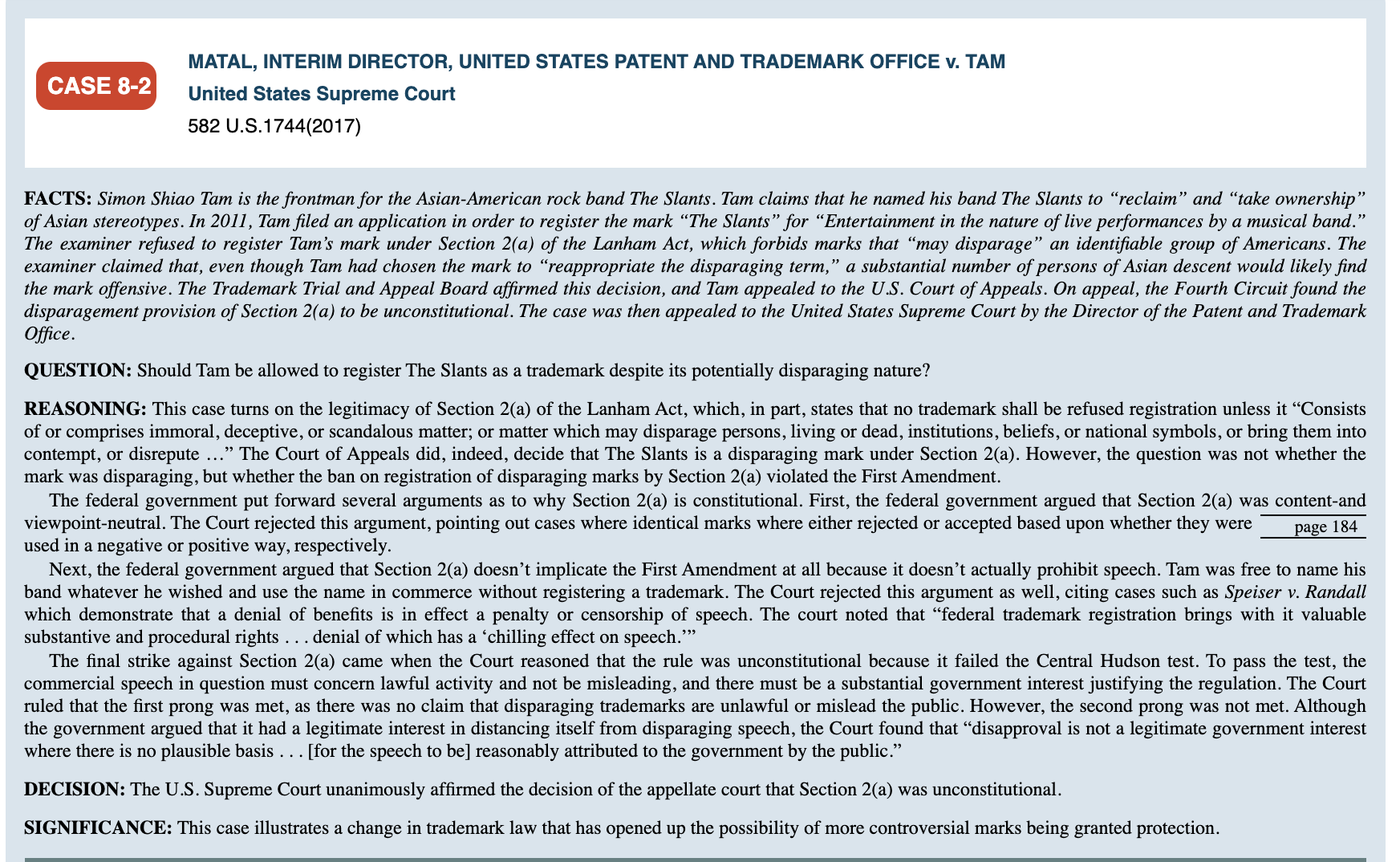1. The Washington football team ended the use of "Redskins" in their name last summer. This was done after they had insisted on keeping it for years but were under intense pressure from their advertising sponsors to change the name or they would withdraw their funding. In business, we choose to do many things even though we are not "legally required" to do them. But why was the trademark even legal?
Review Case 8-2 in your textbook
- The Washington football team trademark, despite the video above, was never ruled illegal and the court action was dismissed after Case 8-2 was decided; what about the Tam Case (Case 8-2) and the Lanham Act kept the Washington trademark from being illegal?
- Case (8-2) below
MATAL, INTERIM DIRECTOR, UNITED STATES PATENT AND TRADEMARK OFFICE v. TAM CASE 3'2 United States Supreme Court 582 U.S.1744(2017) FACTS: Simon Shiao Tam is the frontman for the Asian-American rock band The Slants. Tam claims that he named his band The Slants to \"reclaim" and \"take ownership\" of Asian stereotypes. In 2011, Tom led an application in order to register the mark "The Slants " for \"Entertainment in the nature of live performances by a musical band. " The examiner refused to register Tam's mark under Section 2(a) of the Lanham Act, which forbids marks that \"may disparage" an identiable group of Americans. The examiner claimed that, even though Tam had chosen the mark to \"reappropriate the disparaging term, \" a substantial number of persons of Asian descent would likely nd the mark offensive. The Trademark Trial and Appeal Board airmed this decision, and Tarn appealed to the US. Court of Appeals. On appeal, the Fourth Circuit found the disparagement provision of Section 2(a) to be unconstitutional. The case was then appealed to the United States Supreme Court by the Director of the Patent and Ti'ademark Oice. QUESTION: Should Tam be allowed to register The Slants as a trademark despite its potentially disparaging nature? REASONING: This case turns on the legitimacy of Section 2(a) of the Lanham Act, which, in part, states that no trademark shall be refused registration unless it \"Consists of or comprises immoral, deceptive, or scandalous matter; or matter which may disparage persons, living or dead, institutions, beliefs, or national symbols, or bring them into contempt, or disrepute ...\" The Court of Appeals did, indeed, decide that The Slants is a disparaging mark under Section 2(a). However, the question was not whether the mark was disparaging, but whether the ban on registration of disparaging marks by Section 2(a) violated the First Amendment. The federal government put forward several arguments as to why Section 2(a) is constitutional. First, the federal government argued that Section 2(a) was content-and viewpoint-neutral. The Court rejected this argument. pointing out cases where identical marks where either rejected or accepted based upon whether they were W used in a negative or positive way, respectively. Next, the federal government argued that Section 2(a) doesn't implicate the First Amendment at all because it doesn't actually prohibit speech. Tam was free to name his band whatever he wished and use the name in commerce without registering a trademark. The Court rejected this argument as well, citing cases such as Speiser v. Randall which demonstrate that a denial of benets is in effect a penalty or censorship of speech. The court noted that \"federal trademark registration brings with it valuable substantive and procedural rights . . . denial of which has a 'chilling effect on speech.\" The nal strike against Section 2(a) came when the Court reasoned that the rule was unconstitutional because it failed the Central Hudson test. To pass the test, the commercial speech in question must concern lawful activity and not be misleading, and there must be a substantial government interest justifying the regulation. The Court ruled that the rst prong was met, as there was no claim that disparaging trademarks are unlawful or mislead the public. However, the second prong was not met. Although the government argued that it had a legitimate interest in distancing itself from disparaging speech, the Court found that \"disapproval is not a legitimate government interest where there is no plausible basis . . . [for the speech to be] reasonably attributed to the government by the public." DECISION: The US. Supreme Court unanimously afrmed the decision of the appellate court that Section 2(a) was unconstitutional. SIGNIFICANCE: This case illustrates a change in trademark law that has opened up the possibility of more controversial marks being granted protection







